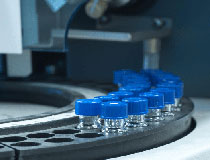Every injury to the muscles, tendons, or bones is typically followed by bleeding in the affected region. This is an important step in the healing process, allowing healing factors to reach the injury site.
Various important healing factors play vital roles during the healing process. These include:
- The Matrix: Provides a suitable environment for cells to grow and repair themselves.
- Growth Factors: Different kinds of proteins supply the needed nourishment to speed up or control the healing process.
These healing factors are called orthobiologic substances, which form the foundation of the rapidly advancing field of medicine known as orthobiologics. It harnesses the body’s own regenerative abilities to repair damaged cells and improve patients’ quality of life.
Orthobiologics is a promising field that offers new, non-invasive options for treating orthopedic injuries and chronic or degenerative conditions. You can find more information about how to qualify for orthobiologic treatment below.
What is Orthobiologics?
Orthobiologics is a specialized field in orthopedics that involves using organic and synthetic materials to enhance the healing of musculoskeletal issues. These substances are delivered either during and after surgeries or via injections to help cure bone and soft tissue lesions.
Orthopedic experts use orthobiologics to speed up the healing process of fractures, muscles, tendons, and ligaments. These products are derived from naturally occurring substances in the body and are administered in concentrated forms to accelerate the healing process.
Essentially, orthobiologics act as therapeutic agents in orthopedics, helping to improve outcomes and promote a more efficient recovery from musculoskeletal injuries.
Benefits of Orthobiologic Treatment
Orthobiologic treatments are excellent treatment alternatives for patients who prefer alternatives to or those who are not good candidates for surgery. They can be especially helpful in managing various musculoskeletal conditions and sports injuries, offering the following benefits:
- Accelerated Healing: Through orthobiologic treatment, patients can expect to experience faster healing times for fractures and injured muscles, tendons, and ligaments than traditional treatments.
- Reduced Pain: These treatments may contribute to decreased pain levels by addressing the underlying causes of musculoskeletal issues and promoting tissue repair.
- Minimally Invasive: Using techniques like injections or arthroscopy, patients can expect smaller incisions, less tissue damage, and quicker recovery times.
- Natural Components: Orthobiologics often use substances naturally present in the body, minimizing the risk of adverse reactions or rejection.
- Improved Joint Function: Treatments that utilize orthobiologics promote healing and reduce inflammation, improving joint function and mobility.
- Customized Treatments: Orthobiologic therapies can be tailored to meet each patient’s needs. Factors such as the type and severity of the musculoskeletal condition, overall health, and treatment goals are considered to ensure that patients receive personalized care.
Different Types of Orthobiologic Treatments
Different orthobiologic treatments are available, depending on the source of the natural components used to promote healing. These treatments are tailored to address musculoskeletal issues through the regenerative potential of platelets, bone marrow cells, and adipose (fatty) tissue:
- Bone marrow aspirate injection is a minimally invasive procedure that involves harvesting the bone marrow and injecting it into the injured area. The bone marrow is rich in growth factor, which is filtered and concentrated before being injected into the site to promote tissue regeneration and healing.
- Adipose tissue injections begin with lipoaspiration (also known as liposuction), a procedure used to remove fat from specific areas of the body. Once the extracted fat samples are processed, the purified cells are injected into the injured or diseased area to accelerate healing.
- Amniotic fluid and tissue products are made from donated amniotic tissue, which comes from the membrane that protects the fetus during pregnancy. These contain cytokines (small proteins that act as messenger cells), growth factors, and other components that can aid tissue healing. They can also help reduce inflammation and promote regeneration.
- Orthopedic growth factors, such as bone morphogenetic proteins (BMPs), are used to stimulate bone growth and improve the healing of fractures or spinal fusions.
Do I Qualify For Orthobiologic Treatment?
Generally, patients who are dealing with the following conditions benefit from orthobiologic treatment:
- Soft tissue damage
- Joint damage
- Chronic neck pain
- Chronic shoulder pain
- Rotator cuff or labral tears
- Tendonitis
- Tennis elbow (lateral epicondylitis)
- Golfer’s elbow (medial epicondylitis)
- Sciatica
- Osteoarthritis
- ACL or meniscus tears
- Bone fractures or breaks
- Spinal conditions
Additionally, you may be an excellent candidate for orthobiologic treatment if you are:
- Experiencing chronic pain
- Frequently using pain relievers to alleviate pain
- Dealing with sports injuries or age-related wear and tear
- Looking for non-surgical treatments
- Willing to explore other options
Although orthobiologics are generally safe, some exceptions may exist, such as those with certain medical conditions or undergoing specific medication regimes. We recommend scheduling an evaluation to determine the root cause of your pain and assess whether orthobiologics could be a good fit for you.
Begin Your Journey Toward a Pain-Free Life Today
Orthobiologics harnesses the body’s regenerative capabilities to promote healing in the joints, tendons, and ligaments. This promising field presents numerous benefits, offering patients the best possible outcomes and improving their quality of life.
At Chicago Cell Therapy & Regenerative Medicine, we specialize in minimally invasive treatments to help you achieve a pain-free life. Book an appointment with us and learn more about how orthobiologics can help you return to your active lifestyle.


 Thanks a lot for getting my hip right. Looking forward to a full recovery and a great season. Thanks again for everything.
Thanks a lot for getting my hip right. Looking forward to a full recovery and a great season. Thanks again for everything.










